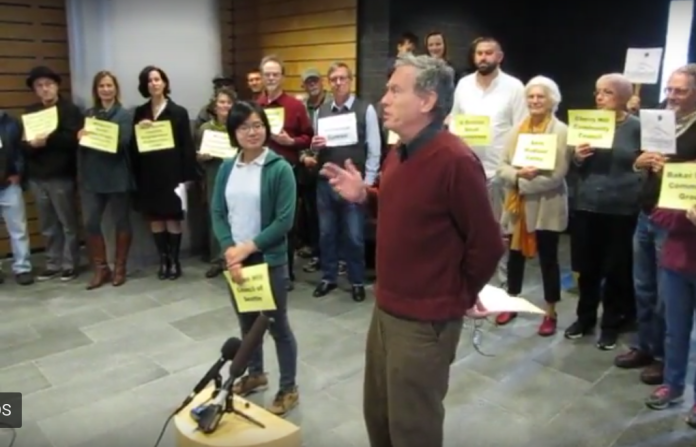A coalition of 24 neighborhood groups announced an appeal of the City of Seattle’s Mandatory Housing Affordability (MHA) rezone plan. The alliance calls itself the Seattle Coalition for Affordability, Livability, and Equity (SCALE) and threw a litany of complaints at the proposal, claiming the status quo would be better for affordability despite the evidence to the contrary.
“The proposed approach would increase the bulk and scale in residential and neighborhood commercial areas; reduce access to light and air; increase traffic; exacerbate parking problems; reduce tree canopy; and otherwise reduce the livability of Seattle’s neighborhoods. Such impacts would make Seattle less attractive for development and, ironically, reduce the ability of HALA to provide funding for more low income housing,” SCALE’s Notice of Appeal states.
The Housing Affordability and Livability Agenda (HALA) has been three years in the making with MHA the crown jewel in an armada of 65 policy suggestions produced by a 28-member stakeholder group of housing advocates and developers. The Seattle Office of Planning and Community Development (OPCD) attempted a multiyear community engagement process to implement the MHA framework, which pairs upzones with inclusionary zoning requirements. OPCD published the Draft Environmental Impact Statement for MHA in June and followed up with the Final Environmental Impact Statement (FEIS) earlier this month.
“An appeals process is an important part of upholding the values of rigor and transparency of our government,” Councilmember Rob Johnson said in a statement. “It’s what ensures we have good information and affords everyone the opportunity to ‘check our work’. There has been a tremendous amount of attention given to the analysis within the FEIS, and a responsiveness to additional analysis, especially around displacement and school enrollment, between the draft and FEIS. It will now be the Hearing Examiner’s role to determine the merits of the appeal.”
Councilmember Johnson, who chairs Planning and Land Use and Zoning committee, anticipates the process will continue as scheduled while the City sorts out the appeal.
“Every day, I hear about Seattle’s urgent need for more housing choices for people of all incomes and family sizes, which is the goal of the MHA program,” Councilmember Johnson said. “Though Council is prohibited from taking final action during the appeal process, we will continue our planned eight-month outreach and deliberation process so that when the appeal is resolved, we can act quickly to implement a critical strategy that will result in more income and rent-restricted housing and more housing options across our city for people of all incomes.”
In typical Seattle fashion, SCALE seeks to drown the proposal in process, not to mention debate aesthetics as many people are being priced out of the city. The Notice of Appeal lists the 43 issues with the FEIS. Here’s a taste of the first 13 things SCALE says the MHA FEIS didn’t adequately consider:
- Neighborhood-specific impacts.
- Description of changes was too vague.
- Doesn’t describe the existing land use environment for each neighborhood or what would change. Didn’t compare to existing neighborhood plans.
- Mitigation of land use impacts.
- Aesthetic impacts.
- Mitigation of aesthetic impacts.
- Transportation impacts.
- Mitigation of transportation impacts.
- Tree canopy impacts (supposedly runs afoul of segmentation rule by using 2035 Comprehensive Plan EIS).
- Mitigation of tree canopy impacts.
- Noise impacts, such as from traffic or construction sites.
- Air quality impacts.
- Mitigation of air quality impacts.
It’s hardly surprising to see Seattle Fair Growth and other choice community councils leading the charge against MHA. These homeowner groups have been engaging–sometimes to derail the various meeting and hearings the City has hosted. Additionally, SCALE members have advocated for contradictory policies. Groups like Seattle Fair Growth and Wallingford Community Council have campaigned to put more zoning capacity along SR-99 even while their appeal bemoans the air quality impacts of putting housing too close to highways. It’s hard to see how they can have it both ways.
It seems a reasonable Hearing Examiner would see SCALE’s voluminous complaints for what they are: concern trolling and desperate delay tactics. Much like a sports team that calls a bunch of timeouts at the end of the game even when the outcome is clear, SCALE is seeking only more time until it faces its inevitable loss.
The members of SCALE are as follows:
Baker Street Community Group ● Beacon Hill Council of Seattle ● Cherry Hill Community Council ● Citizens for Architectural Diversity ● Eastlake Community Council ● Fremont Neighborhood Council ● Friends of the North Rainier Neighborhood Plan ● Friends of Ravenna-Cowen ● Georgetown, Duwamish Valley Neighborhood Preservation Coalition ● Jackson Place Community Council ● Madison-Miller Park Community● Magnolia Community Council ● Morgan Community Association (MoCA) ● Save Madison Valley ● Seattle Displacement Coalition ● Seattle Fair Growth ● Seniors United for Neighborhoods ● South Park, Duwamish Valley Neighborhood Preservation Coalition ● TreePAC ● U District Small Businesses ● University District Community Council ● Wallingford Community Council ● West Seattle Junction Neighborhood Organization (JuNO) ● Westwood Roxhill Arbor Heights Community Coalition
The whole appeal is available online for those looking to subject themselves to it.
The featured image is from the video SCALE posted on its website and features Toby Thaler with other SCALE members behind him at their Monday press conference .
Doug Trumm is publisher of The Urbanist. An Urbanist writer since 2015, he dreams of pedestrian streets, bus lanes, and a mass-timber building spree to end our housing crisis. He graduated from the Evans School of Public Policy and Governance at the University of Washington in 2019. He lives in Seattle's Fremont neighborhood and loves to explore the city by foot and by bike.


